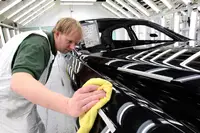Bentley Mulsanne - Creating the New Flagship: Final Assembly - VIDEO FEATURE
SEE ALSO: Additional stories and videos about the new Bentley Mulsanne
CREWE, England - April 19, 2010: Bentley’s unique ability to combine hand craftsmanship with new technology and modern, precision manufacturing techniques permeates every aspect of the build process for the new Mulsanne which enters full production this summer.
Click PLAY to watch video
The 98-strong team of Bentley manufacturing specialists responsible for bringing together the painted body, hand crafted leather hides and wood veneers, the 6 ¾ litre V8 engine and myriad electrical components, employ skills passed down through generations of Crewe car makers. They’re also masters of new techniques such as the handling of the extremely delicate fibre optic cables and a highly-sophisticated electronic alignment system to ensure perfect installation of the wiring harness. Hundreds of exacting quality tests are conducted throughout the build process utilising some of the automotive industry’s most advanced software.
Once the Mulsanne’s painted body shell enters the ‘build hall’, work begins on positioning the electrical loom (which is pre-heated to ensure the cabling is as flexible as possible) and fitting the fuel tank. Several specialist teams will also start working on building major sub-assemblies such as the dashboard and doors prior to installation.
Each car is given a unique electronic ‘Bentley passport number’ which ensures that its complete build specification is available to production operatives at the tap of a button. This passport is far more sophisticated than a specification sheet able to accommodate the extensive standard and optional feature specification of the new Mulsanne. The customer may select from a range of over 100 paint colours alone.
In the dashboard sub-assembly area the fusion of hand-assembly techniques and high technology components is striking. Six team members are responsible for the installation and testing of the complex electrical controls using touch-screen computers. They are supported by two other colleagues who are tasked with hand-fitting the leather top-roll to the dashboard.
“The leather covered dashboard top-roll is one of the most visible areas of the cabin. Two members of the team take responsibility for ensuring a perfect bond between the top roll and dashboard unit and a special material has been developed to protect the leather at every stage of the process,” explains Gary Webster, Mulsanne Production Manager.
Further down the line the new 6 ¾ litre V8 engine and 8-speed transmission are ‘married’ to the car. It takes the team approximately 20 minutes to bring the body and powertrain together, position the suspension and guide the sub frames into their locations. It will then take another 80 minutes to secure the powertrain and make all the connections before the ancillary components such as exhaust, front end module and radshell can be fitted.
As the Mulsanne progresses down the final assembly line, each team works with meticulous care to ensure that the car remains in absolutely pristine condition. As Gary Webster explains:
“Working on the Mulsanne requires an array of skills that goes well beyond just the accurate fitment of the parts. The way you move around the exterior and interior of the Mulsanne is critical because materials like the highly-polished brightware, veneers and leather need such careful handling.
A range of made-to-order protective shields are fitted to the car and our team have an in-depth understanding of the best places to apply pressure. Every member of the build team is respectful of the value and importance of the car they’re making.”
One of the most involved processes is building the sumptuous cabin ‘from top to bottom’. The team start with the headlining and systematically work their way down to the floor, fitting the windows, ‘ring of wood’ waistrail, seats, and doors.
By the time the Mulsanne nears the end of the assembly line it will have undergone over 2,000 checks (one section manager alone will need to complete up to 100 checks before releasing the car to the next stage). It will then be fuelled and ready to be driven onto the shake rig and rolling road test areas. Gary Webster adds:
“Although the Mulsanne is built and ready to be driven, it is still not ready to be delivered to the customer. Our colleagues in the quality team will now road test every single car and prepare it for the final checkpoint area where everyone who has built the car will come together for a final round of inspections.”



